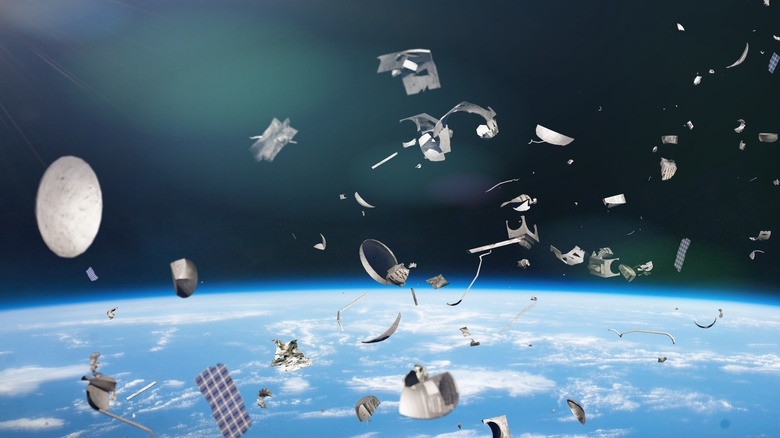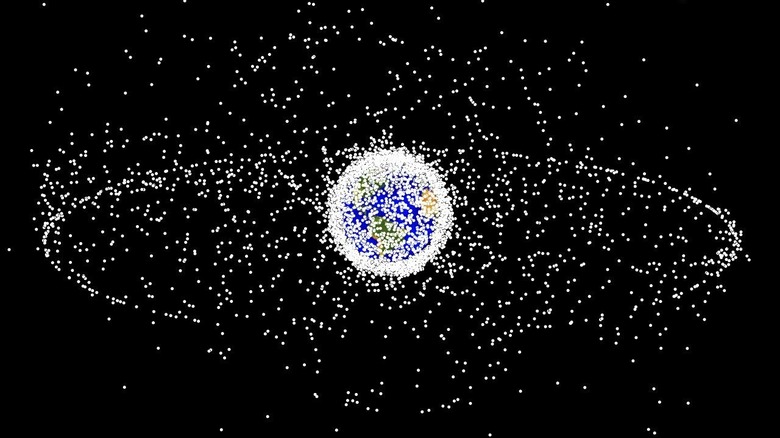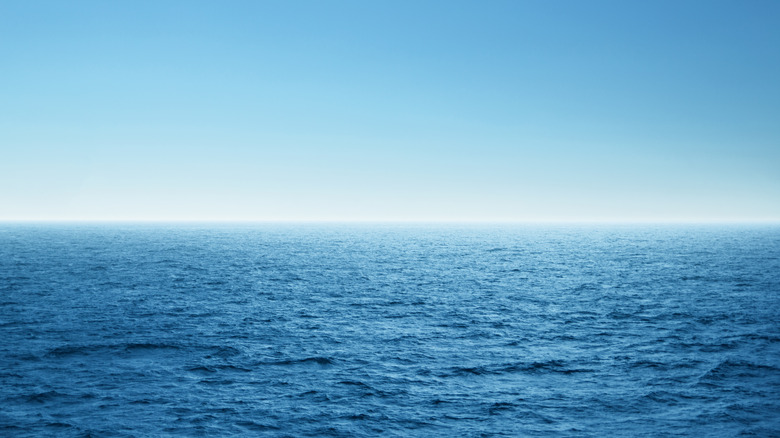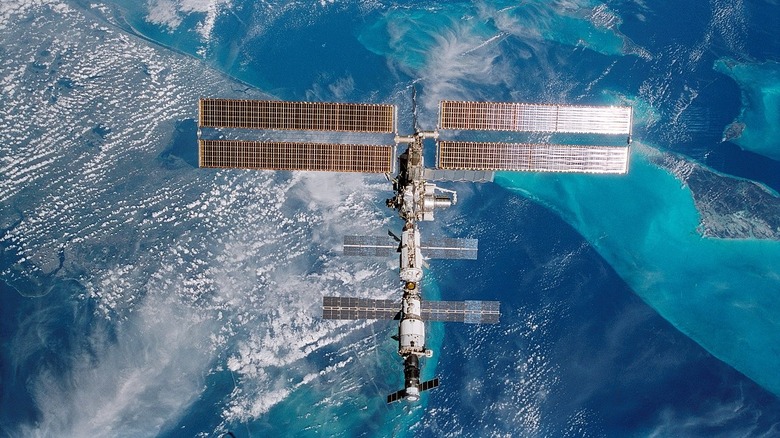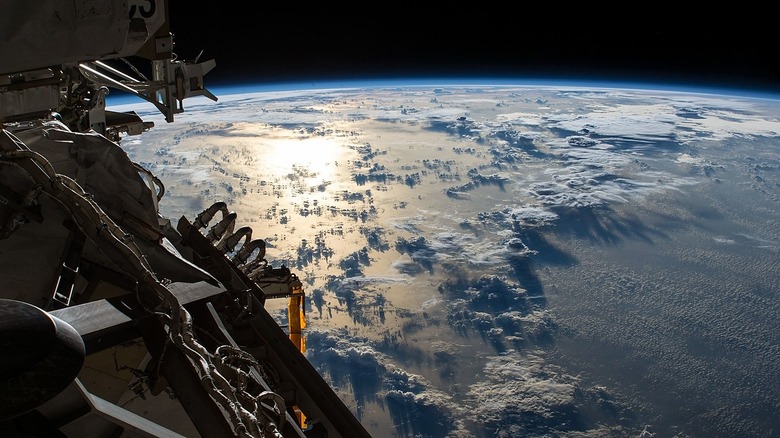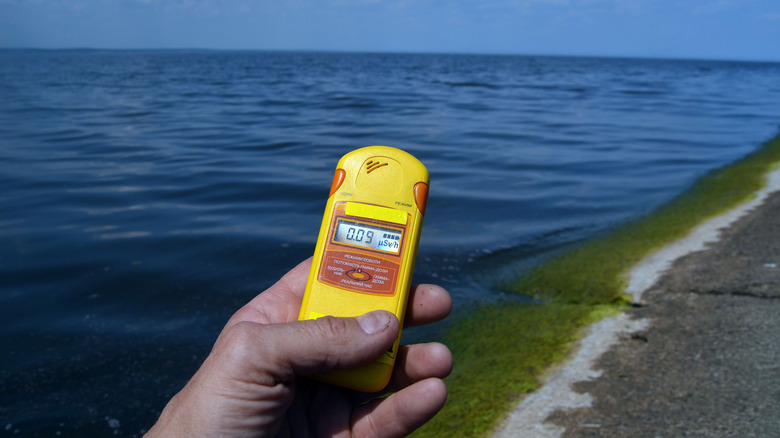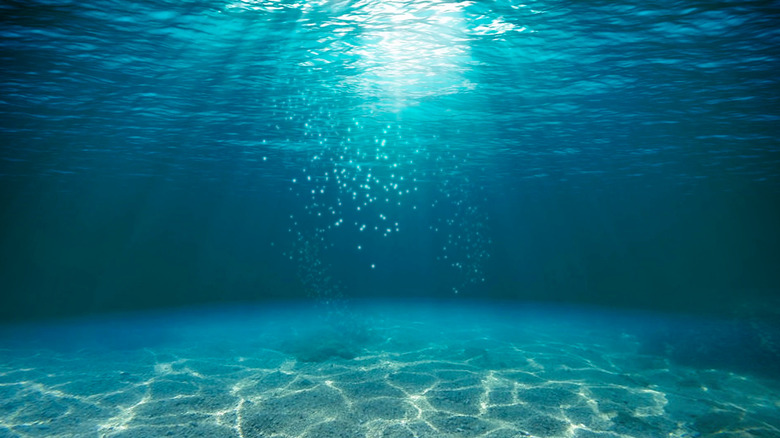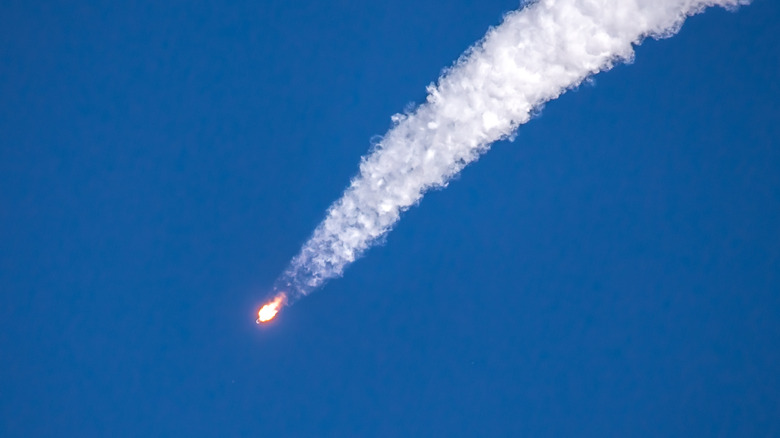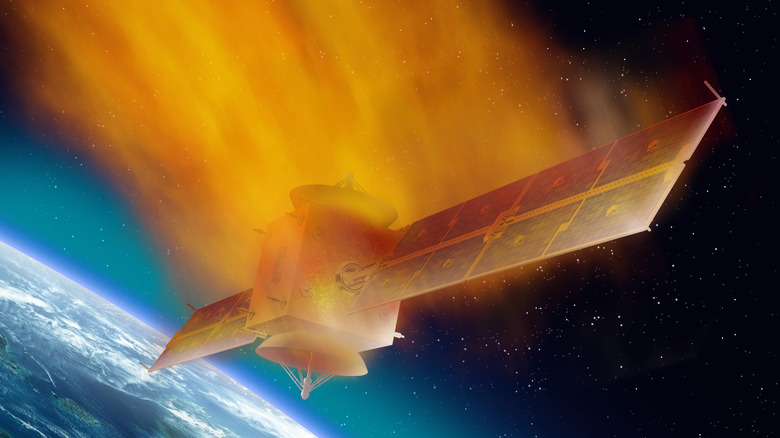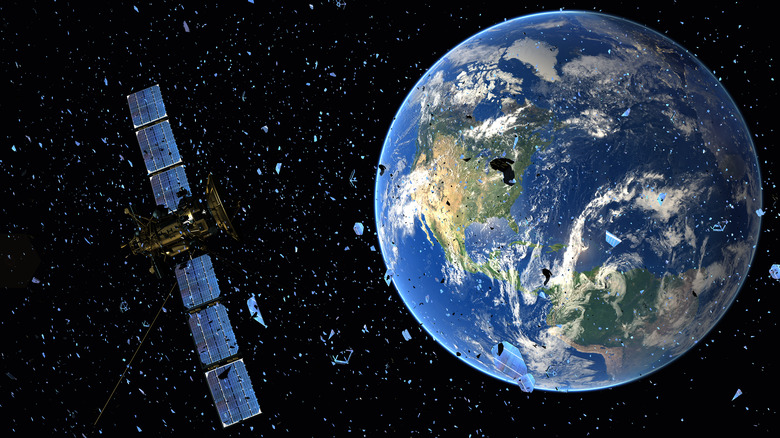How Space Debris Is Affecting The World's Oceans
The Chinese government has once again caused an international outcry with its irresponsible approach to space junk. According to Space.com, a 23-ton used rocket body was left by the China Manned Space Agency (CMSA) to fall back to Earth uncontrolled. In doing so, it revived an ongoing debate about space junk and the environmental concerns stemming from the space industry simply dropping their used vehicles back down to Earth. The sad truth is, uncontrolled falling space debris is nothing new, and it's by no means restricted to China.
It's routine for decommissioned space vehicles to deorbit (that is, to be dropped back down to reenter Earth's atmosphere), and the safe way to do this is to control where they land. Uncontrolled reentry is much more hazardous because there's no way to know exactly where the falling space junk might land. This has been happening for decades, too, with one example in 1991, when a Soviet Salyut space station reentered the atmosphere over Argentina, breaking up as it did so (via Tampa Bay Times). More recently, as a study in Nature Astronomy notes, SpaceX has been repeatedly guilty of allowing debris like used fuel tanks to crash down to Earth unsupervised.
A less reported aspect of all this is what happens after the junk lands. From NASA's famous Saturn V rockets to the most recent CMSA Long March 5B rocket (via Space.com), these vehicles tend to end their lives in the ocean, where their long-term environmental impacts are still largely unknown.
What is space junk and why should we care?
Humanity has been launching things into space for decades, following in the footsteps of the Soviet Union's Sputnik 1 in 1957 (via NASA). However, not everything that's gone up has come back down. After well over half a century, Earth's orbit is littered with debris. According to Britannica, there are estimated to be over 200,000 pieces of space junk in orbit around Earth, and, depending on how high they're orbiting, it'll take anything from years to centuries before they fall back down (although there are plenty that never will). As the USGS notes, around 71% of Earth's surface is covered by water, meaning that falling space junk is most likely to find itself crashing into the sea.
Unfortunately, derelict spacecraft are potentially hazardous to Earth's environment. As ESA explains, space junk can release toxic chemicals as it reenters Earth's atmosphere, and one notable one is chlorine. This can cause damage to Earth's ozone layer, allowing increased amounts of dangerous ultraviolet light to reach the planet's surface. For a long time, falling spacecraft were neglected as a safety hazard, because it was assumed that they'd burn up entirely on re-entry. This assumption, however, has turned out to be a false one. Acknowledging this, there's even an ESA Reentry Safety Page, detailing the risks stemming from the hundreds of spacecraft which are currently falling back to Earth every year. Without care, these can pose a risk to both humans and the ocean environment.
The spacecraft graveyard
There's a largely unknown location on Earth, hidden below the Pacific Ocean in one of the world's most difficult-to-reach places. It's known ominously as the Spacecraft Cemetary, and it can be found near Point Nemo – as far as possible from any dry land, it's known as the international pole of inaccessibility (via Atlas Obscura). Ever since 1971, according to Insider, countries with space programs have been using it as the final resting place for their decommissioned space vehicles. Currently, there are over 260 pieces of space debris down there, slowly decaying below the waves. As well as numerous cargo and resupply vehicles, the graveyard is also home to the wreckage of the Soviet Mir space station and at least one SpaceX rocket. While putting a junkyard in the middle of the Pacific is obviously far from ideal, Inverse notes that the alternative is to leave hazardous debris in orbit, making this currently the best option. Or the least bad option, in any case.
Point Nemo is a remote and barren place. With ocean currents directing nutrient-rich waters away from it, the Spacecraft Cemetary lies in one of the most lifeless parts of the ocean. Unfortunately, even such a remote location is polluted by microplastics, as discovered by passing vessels (via The Guardian). While no one's studied the microplastics in the area in any detail, it's quite likely that at least some of it may have come from the space debris littering the ocean floor in the area.
Rust in peace
There are no plans, short-term or long-term, to stop using the Pacific Ocean as a dumping ground for unwanted spacecraft. As the Washington Post explains, in 2031, it's due to become the final resting place of the decommissioned International Space Station (ISS), currently the largest human-made object orbiting the Earth. Hopefully, though, astronauts will take care of what they leave on board to fall back to Earth. Plastics, as ESA explains, are an essential part of space travel, finding a variety of uses in orbit. Specialist materials, often designed and created for specific purposes, are used in both spacecraft and in space suits for astronauts to wear. As Plastics Today mentions, the ISS is even equipped with The Refabricator, a device to recycle plastics aboard the ISS and 3D print them into new items as required. Unfortunately, in the ocean, these materials will likely behave just like any other plastics, and break down into microplastics. Per Britannica, this plastic pollution is not biodegradable, and already has a pervasive impact on Earth's environment.
A controlled deorbit to land spacecraft in the ocean may come with an environmental impact, but it's still better than a chaotic, uncontrolled descent. In 2018, according to Live Science, China's Tiangong-1 space station reentered the atmosphere, but it was not controlled, with onlookers only having a rough idea where it might land. By sheer luck, it splashed down in the waters near Samoa, only a few thousand miles from Point Nemo.
From the sky to the ocean
For a long time, dropping spacecraft into the ocean has gone largely unquestioned. Long enough that people have started to raise concerns about the practice, and whether it's wise to continue doing so. Denver 7 reports that experts have recently begun calling for more discussion about this, and with good reason. Continuing to use the ocean as a dumping ground is littered with ethical and environmental questions that people are increasingly willing to debate, particularly in a world now much more aware of the need for sustainable practices. Sadly though, in many cases, deorbiting spacecraft over water is the only viable option. There just aren't many safe ways to land a derelict space station.
Legally speaking, Point Nemo is outside the jurisdiction of any government. Being the middle of nowhere, it's fair game for anyone to drop their space junk there. But there's one caveat. As CNN reports, not much is known about the deep ocean environment out there, meaning that it's hard to say what the full impacts will be as the space debris continues to accumulate there. However, experts have reassuring words to say. Oceanographers expect to find little wildlife in the area. In addition, ESA's Space Safety Programme Office stresses that the kind of things left under the sea are typically non-toxic objects made from metals like titanium or stainless steel, pointing out that there are far more sunken ships and lost cargo containers under the sea than there are spacecraft.
Toxic rocket fuel
One concern about space junk is that some reentering objects can release toxic chemicals inside Earth's atmosphere. One particularly concerning example is hydrazine, used widely as a rocket fuel. It's an extremely toxic and dangerous chemical to work with. The EPA notes that hydrazine is corrosive and can cause chemical burns and skin irritation, as well as being a carcinogen – though it also mentions that hydrazine tends to be broken down quickly in the environment. All the same, the use of hydrazine as rocket fuel is full of concerns that NASA is well aware of, and researchers have already put a lot of work into less dangerous fuels for spacecraft to use.
The possibility of spacecraft spreading toxic chemicals when they land is nonetheless concerning enough that the International Maritime Organization has been keeping a close watch for toxic splashdowns and their potential effects. As Canada's National Observer reports, this was prompted by complaints by Inuit people about Russian space debris landing in the waters they depend on for food. While space agencies are trying to phase out the use of hydrazine, there are still concerns over how toxic the replacements may be. Being a fuel, most hydrazine is likely to burn up on reentry. However, a study in the California Western International Law Journal notes that some amount of hydrazine is still likely to reach the surface of Earth, where it's known to be extremely toxic to aquatic life.
Radioactive waste from space
Alongside the chemical hazards, another potential hazard from falling spacecraft is radioactivity. As a study in the California Western International Law Journal points out, radioactive materials are used in some spacecraft as an energy source, with an example being the radioisotope thermal generators (RTGs) now mostly used for interplanetary space probes. It's likely that space travel may increasingly come to use nuclear energy in the future, too, as Chemical and Engineering News reports. As serious plans are made to send spacecraft to the Moon and even Mars, nuclear energy is a promising power source for future astronauts to use, but also something which needs to be treated with the proper care and attention.
The prospect of sending nuclear material into space raises a lot of safety concerns, including how it might be disposed of. The International Atomic Energy Agency has already begun debating and assessing potential risks. They note that it's not unheard of for nuclear-powered spacecraft to go through an uncontrolled reentry and crash land on Earth, citing the 1978 crash landing of the Soviet COSMOS 954 spacecraft as an example. The most difficult part of an uncontrolled descent like this is that it's hard to predict where exactly the craft will land. A rapid response is required, but this will also be much more difficult if the defunct spacecraft lands in the sea. An additional problem, as CNES discusses, is that ocean currents can quickly disperse radioactive material over a wide area.
How the atmosphere affects the oceans
Spacecraft can also have effects on Earth's atmosphere, which, in turn, affect the ocean. One concerning problem with spacecraft, as Space.com explains, is that they can impact the ozone layer, resulting in ozone depletion. This can happen both during launches and when a spacecraft reenters the atmosphere. What's more, the exact effects during reentry aren't well studied. For ozone, chlorine is one of the most damaging things that can be released into the atmosphere. Per the American Chemical Society, a single atom of chlorine can destroy thousands of ozone molecules, and falling spacecraft are known to release it. The result of less ozone is that more harmful ultraviolet radiation reaches Earth, including Earth's oceans, where it can have some of the most harmful effects.
Ultraviolet radiation can wreak havoc on marine ecosystems at the most fundamental levels. According to Oceanos, increased ultraviolet can harm the phytoplankton which makes up the base of the marine food web. The resulting lack of food causes a cascading effect, leading to widespread animal populations dying off. What's more, as a study published in the journal Photochemical & Photobiological Sciences notes, increased ultraviolet can cause stress to a variety of other marine life, including crustaceans, amphibians, fish, and corals. This additional stressor is particularly harmful to corals, which are already under serious threat from climate change.
Low flying trash
As well as ecosystems, space junk can also affect people. There are even a few notable examples on record. The first known incident of people being directly harmed by space junk at sea was reported by The New York Times in 1969, when a piece of Soviet debris struck a Japanese freighter, injuring five people. While these sailors may have been particularly unlucky, there are others who don't have the luxury of simply moving away. Pacific Islanders have expressed their concerns before, as Russia was planning to deorbit the decommissioned Mir space station.
In 2001, IOL reported that the South Pacific Forum sought assurance from Russia that their people's homes wouldn't be damaged as the defunct space station was dropped into the ocean. They had good reason to worry. At the speeds involved in Mir's reentry, fragments of the space station could easily move fast enough to shatter reinforced concrete. At the time, Russia needed to take out $200 million (U.S.) of insurance, just in case of any unexpected property damage. NASA will likely need to make similar assurances when the International Space Station is decommissioned in the coming years. Meanwhile, Pacific islands aren't the only places potentially affected by space junk in the ocean. In 2021, a cylindrical object washed ashore in Oregon. According to Smithsonian Magazine, it was most likely a hydrogen tank made by SpaceX, that ended up in the ocean after a mishap caused them to lose control of a Falcon 9 rocket.
Unregulated space debris
Falling space junk, as Mashable points out, goes largely unregulated. This has caused a lot of safety concerns, particularly in the global south, about whether falling garbage might be putting people at risk and how they can be protected from it. While, to date, no one has actually been killed by debris falling from the sky, it's nonetheless quite disconcerting for many people to realize that broken-down spacecraft can simply fall from the sky above their heads, and the most worrisome objects are larger pieces of space junk, like spent rocket boosters. A 2022 study in Nature Astronomy carried the warning that uncontrolled rocket reentries pose unnecessary risks and that governments at the most risk should demand that spacefaring states take greater responsibility. It's been shown that the majority of space junk tends to fall in the southern hemisphere and, as well as South America, Africa, Oceania, and southern Asia, it's notable that much of the global south is also covered by three of Earth's five oceans (via NOAA).
In response to mounting concerns about space junk, 2022 saw the FCC introduce stricter measures to try and address the issue. As Reuters reports, however, these measures chiefly concern removing space junk from orbit and don't do much to address how and where it's sent back to the ground. Wired notes that it's likely most of this detritus is going to simply end up dumped into the ocean.
The future of space junk
As humanity continues to launch satellites and spacecraft into orbit, space junk is only going to become a more pressing concern, and, in the future, it'll very likely make space travel an even riskier endeavor than it already is. Per Space.com, over 100 tons of space junk is currently estimated to fall to Earth every year, but no one is really doing anything about it. Much of that space junk will ultimately be headed for the ocean, either accidentally or on purpose.
According to Ars Technica, the only real solution currently considered for space junk is simply to reserve enough fuel for a controlled reentry – in other words, piloting defunct spacecraft directly into the sea instead of simply leaving them to fall there. It goes unspoken that the need to make sure there's remaining rocket fuel to accomplish this will also increase the likelihood that remaining unspent fuel may end up in the ocean too. The sad truth, though, is that this imperfect solution is still the only viable option. There aren't currently any ways to salvage or recycle the garbage that's in orbit, and it's unlikely anyone's going to recover any of the junk that's already sitting at the bottom of the ocean. Until another option becomes available, space junk is likely to keep ending up in the Pacific. And as Popular Science notes, even the experts still don't know exactly what the long-term effects of this might be.
